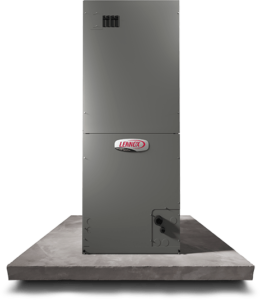
Every once in a while here at Weather Master, we like to write a blog post specifically about common HVAC terms, and on differences between types of units.
So today, we’re going to be answering the oft-asked question, “What is an air handler?”
What Is an Air Handler?
An air handler is actually the inside component of your air conditioner / heat pump. (Keep in mind, when we say indoor part, we’re not talking about a wall-mounted unit.) It looks like this:
It’s the indoor part of what’s called a “split system.”
So, what does this air handler, which looks a lot like a furnace, actually do? Well, it handles air. Lesson over!
…Just kidding.
What we mean by “handling air” is, this is the part of your air conditioner that actually cools down the air from outside, or the part of your heat pump that heats/cools the air (heat pumps are capable of doing both).
Parts of an Air Handler
The evaporator coil on your air handler is either hot or cold, which heats or cools the outside air passing through (according to how you set your thermostat).
Then, the next part of the air handler is the blower motor. There are three different types of blower motors: single-speed, multi-speed, and variable-speed. These are pretty much what they sound like:
Single-speed is only capable of working at one speed. So if you have your heat on, and the temperature in your house drops below where you set the thermostat, the single-speed blower turns on. But, you can think of this like a stove-top burner that only turns on or off. It’s less efficient! There will be times where your house is colder than you like, as the heat pump turns on and off randomly to try and meet the desired temperature. This limitation of only turning on or off wastes energy.
A multi-speed blower has two speeds: lower and higher speed. If your heat pump’s air handler really needs to work hard, then it will blow on its higher setting. This need-dependent ability to switch between settings increases energy efficiency.
Last but not least, the variable-speed blower has more than two settings; it’s basically on all the time, constantly adjusting blower speed based on your home’s needs.
This is a more expensive type to invest in initially, but over time it will pay for itself, because instead of operating as on / off, it will precisely match the temperature you want. This avoids wasting energy. Check out our Lennox Elite gas furnace, which comes with a variable-speed blower motor and SilentComfort technology.
Air Handler Efficiency
Speaking of energy efficiency, let’s talk about air handlers and “SEER” ratings: SEER is a term we covered earlier in our August blog post. If you forgot, that stands for Seasonal Energy Efficiency Ratio.
Remember that a furnace’s efficiency is measured as AFUE (Annual Fuel Utilization Efficiency), the heat output divided by the fuel input. The result is a percentage showing how much fuel actually turns into heat.
The “SEER” rating is basically the same thing, but for air conditioners / heat pumps (dividing heating/cooling produced by the amount of electricity used).
So, what does that have to do with air handlers? Well, it turns out it’s very important that the SEER rating of your air handler matches the SEER rating of the air conditioner or heat pump. Another way of stating this is, the indoor component and outdoor component of your HVAC system need the same efficiency rating.
If one is more efficient than the other, then you can have an even greater efficiency LOSS, says the Air Conditioning, Heating, and Refrigeration Institute. With a SEER mismatch between indoor and outdoor components, the whole thing becomes 30% less efficient or worse. A mismatch between your air handler and your air conditioner / heat pump can even make the whole system fail sooner!
Our contractors can ensure that these components of your system are properly matched!
Ductless HVAC Systems
Most North Carolina homes have a split system heating and cooling, an air conditioner or heat pump paired with the indoor furnace or air handler. But many people find that a different kind of split system called a ductless split system is actually a way better choice for them, and that the Energy savings are through the roof.
If you don’t need to heat all the rooms in your house, a ductless split system brings cost-effective comfort only to the rooms you need it in.
To learn more about ductless split systems or any of the heating and cooling systems we offer, feel free to visit this page or give us a call at (919) 853-7910!

